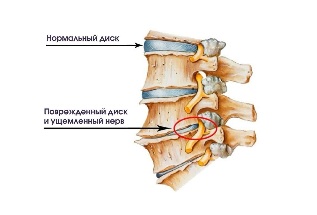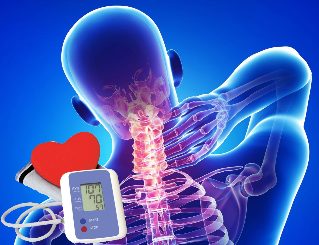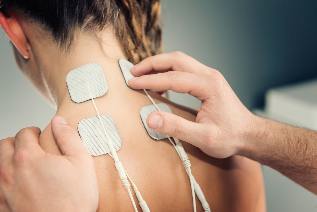Cervical osteochondrosis is a certain dystrophic changes of the intervertebral discs in the neck.

A negative impact will affect not only the discs themselves but also the vertebrae, cartilage, soft tissue. The main feature of the cervical spine is the fact that it is not a vertebrae a reliable structure in comparison with other organizational units, which makes this area very sensitive. The vertebrae are located here, close to each other, as well as the arteries, to which the power of the human book.
If there is a displacement of the vertebrae, a possibility is compression of nerve fibers and arteries, which will inevitably go to an event hernia vertebrae between the protrusion, i.e., changing the structure of the spinal disc.
What is this?
Osteochondrosis of a cervical spine (Osteohondroz) is a degenerative-dystrophic lesions of the intervertebral discs, or which damage discs, vertebrae, joints of the cervix, reduced an ep-je, the intervertebral discs. The disease progresses if untreated, and headaches can cause circulatory problems and even hernia. Like osteoporosis, the disease occurs because the mineral metabolism diseases of the bones, joints less strong.
Osteochondrosis instability can cause a cervical spine (the symptoms, treatment similar to that of the chondrosis, but with many features), which is often accompanied by displacement of the vertebrae. In turn, this accelerates the development of degenerative disc disease, destroying the spinal Class.
Stage
The treating physician should determine the degree of development of degenerative cervical disc disease based on history, perform a medical examination of the patient. Difference a just four degrees:
- In the first degree. The illness, the patient has mild pain in the neck, which can be more intense, if you start out with the man in the head.
- In the second grade. It could be that a patient complaining of a very strong pain in cervical spine, which is localized in the upper limbs. The clinical picture shows that at this stage in the development of the disease can be observed in a nerve fibers causing intense pain. It should also be noted, headache, weakness, general malaise.
- In the third grade. The pain becomes almost continuous, radiation is also on the shoulder or the arm. Some patients diagnosed with hernia of the intervertebral discs, which leads to the loss feeling a of upper limbs. A medical study, a noticeable decrease in the mobility of the cervix, the pain, the palpation.
- In the fourth grade. At this stage, the disease is a cartilage disc is almost completely destroyed. A place of connective tissue, which further worsens the patient. He begins to feel the pain, the noise in my head, poor orientation in the space. This suggests that the artery is clamped, which prevents a force of nature, the book publisher.

The symptoms of a degenerative disc disease in a cervical
Important the symptoms of a degenerative disease with a disc or cervical dizziness, headaches, arterial pressure jumps.
The disease is difficult, pain is sometimes not visible, but the symptoms you deleted a character, in fact, uncontrolled use of strong painkillers mask symptoms of the disease. A patients feel pain, they're healthy, and this continues until the development of irreversible processes in the tissues, the joints of the neck.
A Headache is cervical osteochondrosis
This is one of the most common specific signs of many diseases. Headaches are especially prevalent in the female population. It is difficult to determine, because it hurts the head, in fact, the associated lesions, a spinal. There are about 14 different look makes people a headache.
The most common cause of headaches with a description of pathology:
- Spasms of cerebral blood vessels;
- A nerve roots;
- Reflex increase in intracranial pressure.
A Headache is cervical osteochondrosis remember the feeling, when a high blood pressure, angina or stroke. In particular, the middle-aged or older, typically a risk of developing stroke or heart attack.
You feel the pain can be paroxysmal, continuous, throbbing, dull.
When the heart diseases patients complain of an unpleasant feeling in the chest, accompanied by arrhythmia a heart. Identify for the reason that only a professional doctor. In the case of headache with nausea, dizziness, chest pain, to take the ECG.

Dizziness of a cervical osteochondrosis
This is not always a condition clearly indicating that the disc disease degenerative cervical spine.
Dizziness can be the result of:
- An inflammation of the middle or inner ear;
- Spasms of cerebral blood vessels;
- Violation of transmission of nerve impulses;
- Problems in the vestibular system;
- Diseases of the cardiovascular system.
There are no clear criteria, dizziness osteochondrosis. There are, however, they are systemic, and not a system-level dizziness, there are certain differences.
We recommend that you know the difference between the systemic and not a system-level dizziness, it helps the cause to determine a unusual State:
- System dizziness, the feeling of a circular motion of the surrounding objects or organization, which is a consequence of dysfunction of the vestibular system, visual analyzers receptors in the joints, muscles, epidermis (low back pain of various concentrations);
- Not a feeling of systemic dizziness, feeling shocked, uncertain condition in a vertical position. If you do not system, level of dizziness-feeling circle-rotation is missing, this is an important difference, as signs.
People who feel the dizziness of a specified type, should be examined, and an experienced doctor, primarily a neurologist, or (if there is a suspicion that a disease, an ear, throat) an otolaryngologist.
The reason for this is that a emergency hospital treatment, not related to degenerative disease is a disk cervical spine, the patient's identification (except vertigo) these are the signs of the mint:
- Facial paralysis, numbness of the shoulder strap;
- Severe headache, on the background of a deterioration of health;
- Violation of coordination of movements;
- Or The loss annihilation of consciousness.

The blood pressure in the cervical osteochondrosis
A connection for a degenerative cervical disc disease, low or high blood pressure have long been established. The neck vertebrae, important nerve endings and blood vessels.
Characteristic pressure changes during the day. High blood pressure for a long time this is not a characteristic of a disease. Reflex irritation of the nerve endings, short-term spasms of the blood vessels, because all of a sudden a day to day dynamics of arterial hypertension.
The distinctive feature of the increased pressure in cervical osteochondrosis is a combination of the following symptoms:
- Headache;
- Pain in the limbs and the chest;
- The reduction of the sensitivity of the neck area;
- After the event of pressure peaks in a stress, muscle tension, prolonged stay in an uncomfortable position, or other similar situations.
Ezek a characteristics should be taken into account for the individual differentiation, high blood pressure, the different Genesis.
Spikes HELL and a rapid deterioration, based on the health seeking urgent medical help.
Syndromes of osteochondrosis
A clinical a picture disc neck degenerative disease fit into the level three a couple of syndromes. Syndrome this is multiple symptoms that occur together.
Low back pain in the following symptoms:
- Financial production sales purposes. It is also called vertebra, which indicates that it is involved in a pathological process, bone and cartilage. This lead to such symptoms onset: restriction of motor activity of the neck, pain when you bend, radiological changes, a picture, a cervical spine. This is the simultaneous appearance, ezek a sign of a spine-syndrome. A similar clinical symptoms were observed in myositis (pathology of muscle tissue), as well as a painful movement, a companion of many other diseases.
- Syndrome artery vertebral. Then, if the the participation of vascular bundles, which are responsible for the blood flow to the tissues of the Central nervous system. The symptoms suggest that the book tissue ceased to receive the high amount of nutrients. How to recognize this syndrome? The first signs of dizziness, the feeling of a noise in the ears, changes in blood pressure, the appearance of the "veil" before the eyes of. This suggests that the vertebral arteries stavlennia condition. Have All the vessel's own nerve endings. If you squeeze those Innervate an artery vertebral displayed, headache, numbness, transient loss of vision on one side. In the end, a vascular changes lead to the fact that the brain needs is oxygen. At this time, a person feels drowsiness, transient disturbance of consciousness, loses focus, and control, worse think it's working now information. You have to be So clinical differentiation of degenerative cervical disc disease, atherosclerosis, a vertebral artery and compression by tumor or inflammation.
- Heart syndrome. I saw a burning chest,shortness of breath. The words find out the common heart palpitations, become, free, irritable. This is a pattern characteristic of heart disease for example angina, coronary syndrome, heart attack. An accurate conclusion cause symptoms such can be done after the patient goes through an EKG.
- Radiculáriszt syndrome. A cervical innervates 8 pairs of nerves, each of which roots place nerve exit the spine. The participation of osteochondrosis, patients have decreased sensitivity, or vice versa pain. It may be that the numbness of the neck, if the pain is reduced feel, a language, a behind the ear, pain in a supraclavicular area. Sometimes, swallowing disorders, movements of the upper extremities, numbness of the fingers.
First aid at home, an exacerbation of osteochondrosis
If you have a strong pain you can use painkillers such as Up or Tempalgin Baralgin. If the above medicines relieved it isn't, then Nsaid-t (Nis, or Diclofenac).
Often used to "distract" means, for example, that a Capsicum plaster that does not heal, but warm to the painful area, and divert the pain. In the case of edema formation in the region is an inflammation, the patient may drink infusion of herbs or diuretic for 3-4 days. It is possible that such a cure osteochondrosis methods? Ezek measures, however, is only temporary, the reason for treatment, contact your doctor.
Noted to to what treating physician, the low back pain. If you suspect reason that the pain of a cervical spine incidence of low back pain, you should consult a neurologist. This is a special focus on diseases of this kind. Some health institutions are narrow-minded professionals dedicated to the diseases of the spine. If a clinic is a spine, to ask you have to how to cure the disease, immediately.

How to treat an osteochondrosis of cervical cancer?
A mode section, a development to cure lower back pain without medication, that's enough to review the diet, daily routine, regularly carry out a complex of special exercises. Advanced form of the disease effective treatment is only possible on condition of application of various drugs, which help to delay degenerative changes in the vertebrae.
A complex of therapeutic measures necessarily involves physiotherapy – electrophoresis with drugs, ultrasound, magneto therapy, therapy. Ezek a method to help cope with the pain, inflammation, swelling of the tissues, improves metabolic processes and blood circulation.
Medication
The main method of treatment of a degenerative disease of a disk, cervical spinal medication, physical therapy, massage, head-neck area, in particular, effective therapeutic exercises cervical osteochondrosis. A main group of medicines for the disease:
| Name | The principle of operation of |
| Non-steroidal anti-inflammatory drugs (Nsaids). The voltaren, Nise, Movalis, was, Ketonal, Ketanov, diclofenac, nimesulide, and other | To reduce the pain, reduce the inflammation, swelling, the spine, the nerve that was damaged. |
| Drugs that improve blood rheology and blood flow. This burden, trental. | Improve the nutrition of a damaged nerve roots and improves blood flow to brain. |
| The B vitamins combilipen, hunga ma, milgamma, neurobion. | It improves the metabolic processes in the nervous tissue. |
| The muscle relaxants. This mydocalm, sirdalud, chiseled of, tizanidine, etc. | There are medicines that the muscle to relieve spasm. |
| Chondroprotectors. (The, as well as glucosamine, chondroitin) art for, teraflex, doppelgerts, toadstone, Andronovói, structovis, watched. | This medicines to restore the cartilage tissue, including damaged intervertebral disc. |
By taking a pill, degenerative disc disease, remember to have a significant effect on medication a medicine only if it is combined with other techniques, including exercise. I also noted, you need to have a physician appointed as a disease treatment on the basis of a stage or other characteristics.












































